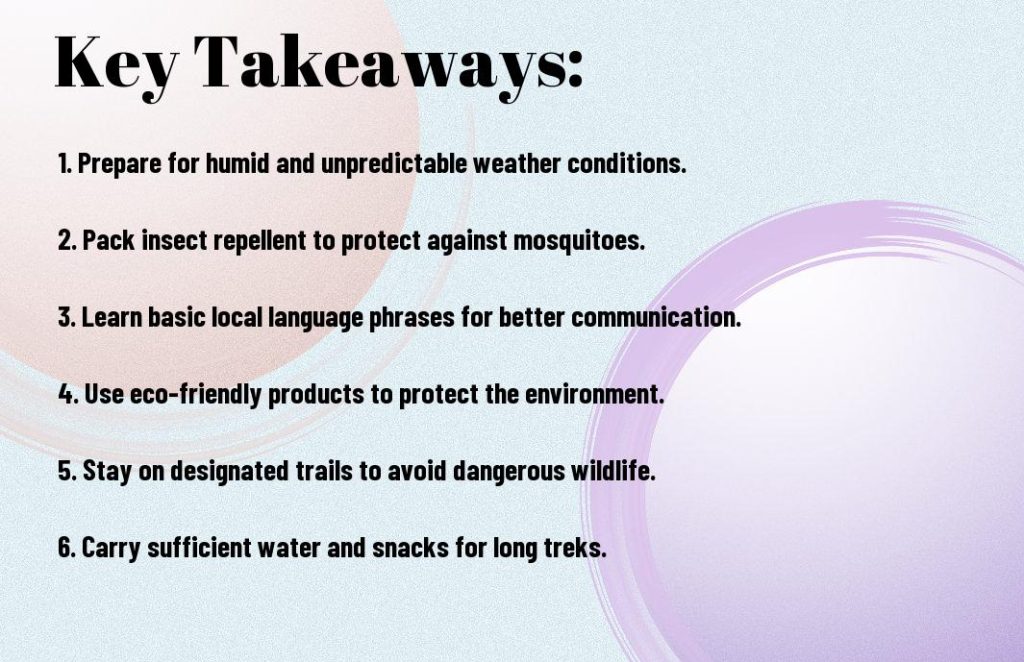Subscription required
It’s vital to prepare thoroughly before venturing into South America’s jungles, as this vibrant and diverse environment presents unique challenges and wonders. You’ll encounter dense vegetation, exotic wildlife, and unpredictable weather, all of which require careful planning to ensure your safety and enjoyment. Understanding local customs, health precautions, and sustainable travel practices will help you make the most of your adventure. This guide will equip you with important insights to navigate the jungles confidently and responsibly, so your experience can be both enriching and unforgettable.
Key Takeaways:
- Prepare for diverse weather conditions and bring appropriate clothing to handle humidity, rain, and insects.
- Understand the local wildlife and ecology to ensure a safe and respectful jungle experience.
- Plan logistics carefully, including guided tours, permits, and health precautions like vaccinations and insect repellent.

Essential Preparations
To fully experience South America’s jungles, you need thorough preparation. This includes understanding the environment, arranging necessary vaccinations, and planning your itinerary carefully. Identifying reliable guides and familiarizing yourself with local customs can enhance your adventure. Preparing mentally for the challenges of a humid, dense jungle will help you stay safe and enjoy your visit. Taking these steps ensures you are ready to explore this unique ecosystem confidently and respectfully.
Health Precautions
Across South America’s jungles, there are health risks such as insect-borne diseases and tropical illnesses. It’s important to get appropriate vaccinations and carry insect repellent with DEET. You should also be cautious about the water you drink and consider anti-malarial medication if recommended. Inform yourself about regional health advisories and pack a basic first aid kit to handle minor injuries or ailments. Proper health preparations will help you stay well throughout your jungle journey.
Packing Essentials
On your trip to the jungle, packing correctly can make a significant difference. Bring lightweight, moisture-wicking clothing, sturdy hiking boots, and a wide-brimmed hat for sun protection. Don’t forget a quality rain jacket, mosquito net, and a reliable flashlight. Also, include waterproof bags to protect your gear. These items will keep you comfortable and prepared for the unpredictable weather and terrain you’ll face in the jungle.
Another important aspect when packing is to consider compact and multifunctional gear. For instance, a travel towel that dries quickly and a versatile multi-tool can save space and enhance your practicality. Including extra batteries or a portable charger is wise, as access to electricity may be limited. Preparing your luggage thoughtfully means you’ll carry everything needed without unnecessary weight, allowing you to navigate the jungle more easily.
Understanding the Environment
The jungles of South America present a unique and vibrant ecosystem that you will find both fascinating and challenging. When you visit, you are stepping into a world teeming with life, dense vegetation, and intricate natural processes. It’s important to have a solid understanding of this environment so you can appreciate its complexity and navigate it safely and responsibly during your adventure.
Flora and Fauna
Along your journey, you’ll encounter an astonishing variety of plants and animals, many of which exist nowhere else on Earth. From towering hardwood trees and thick vines to colorful birds, elusive mammals, and diverse insects, the jungle’s biodiversity is staggering. Knowing about this rich flora and fauna helps you recognize the delicate balance of life and avoid disturbing the habitats you explore.
Climate and Weather Patterns
Climate in South America’s jungles is typically hot and humid, with heavy rainfall occurring throughout much of the year. You should prepare for intense humidity and sudden, heavy showers that can drastically change conditions quickly. Understanding these weather patterns will help you pack appropriately and plan your activities to make the most of your visit.
In addition to frequent rain, temperatures can vary between day and night, often remaining warm but occasionally dropping in certain highland jungle regions. The wet season tends to bring flooding and increased insect activity, while the dry season offers easier trekking conditions but less water availability. Monitoring local weather forecasts before and during your trip will enhance your comfort and safety in this dynamic environment.
Safety Considerations
Not all risks in South America’s jungles are obvious, so you need to stay alert to protect yourself. Understand local health advisories, secure your belongings, and always travel with a guide who knows the terrain and customs. Avoid isolated areas at night and be mindful of natural hazards like rapid rivers and unstable trails. By preparing and staying cautious, you enhance your chances of a safe and memorable jungle adventure.
Wildlife Encounters
Wildlife in the jungle is fascinating but can also be unpredictable. You should keep a respectful distance from animals, avoid sudden movements, and never attempt to feed them. Insects like mosquitoes carry diseases, so insect repellent and protective clothing are important. Staying calm and following guides’ instructions helps ensure that wildlife encounters are safe and enriching experiences rather than dangerous situations.
Indigenous Communities
Against the backdrop of deep jungle traditions, indigenous communities have their own rules and customs which you must respect. Engaging with local people respectfully can enhance your experience, but you should never intrude or disrupt their way of life. Seeking permission before taking photos or entering their territories shows cultural sensitivity and fosters positive interactions.
And when visiting indigenous communities, make sure to learn about their history and daily challenges beforehand. Your respectful behavior supports their dignity and promotes sustainable tourism. Approach interactions with humility and openness, knowing your role as a guest is to observe and learn rather than impose. This respectful mindset creates meaningful connections and a richer journey.
Navigating the Jungle
Despite the dense and often intimidating environment of South America’s jungles, you can navigate with confidence if you prepare properly. The terrain may be challenging, with thick foliage and uneven ground, but having the right tools and local knowledge will ease your journey. Understanding the layout, using maps or GPS, and recognizing natural landmarks are necessary strategies to help you maintain your bearings. Your safety and enjoyment depend on staying alert and planning your route carefully before heading deep into the wild.
Trails and Transport
Above all, be aware that jungle trails can vary from well-maintained paths to barely marked routes that challenge even experienced hikers. Access to these areas often requires boats, canoes, or even local guides skilled in river transport. You should prepare for a combination of walking and water travel, which is common in many regions. Reliable transportation options depend on the location and infrastructure, so researching your specific route beforehand ensures you’re ready for the mix of travel modes you’ll encounter.
Guided Tours vs. Solo Adventures
Around the decision between guided tours and solo adventures, consider your experience level and comfort in the jungle. Guided tours offer expert insight, safety, and access to hidden spots, making them ideal if you want a comprehensive experience without the stress of navigation. However, if you’re confident and seek independence, solo trekking allows for personal discovery at your own pace, though it requires thorough preparation and self-reliance.
Hence, choosing between a guided tour and a solo adventure should align with your skills and objectives. Guided tours typically provide structured itineraries and safety nets that help you maximize your trip while minimizing risks. Solo ventures, while rewarding, compel you to manage emergencies and route-finding independently, demanding more preparation. Evaluate your comfort with navigation, local wildlife, and emergency response to make an informed decision that enhances your overall jungle experience.
Cultural Insights
Now that you’re planning your adventure into South America’s jungles, understanding the cultural landscape is as important as the natural one. The region is rich with diverse traditions, beliefs, and social norms shaped by indigenous peoples and colonial history. Engaging respectfully with local communities will deepen your experience and open doors to authentic interactions. Embrace the opportunity to learn from the people whose heritage has shaped these vibrant landscapes, ensuring your visit is both respectful and enriching.
Local Customs and Etiquette
One key aspect to consider when visiting South America’s jungles is the variety of local customs and etiquettes. Different communities may have distinct ways of greeting, dress codes, or social norms that you should observe. For instance, it is polite to greet with a handshake or a gentle nod, and dressing modestly in rural areas shows respect. Being attentive to these customs will foster goodwill and help you connect more meaningfully with the people you meet during your journey.
Language Tips
About communicating effectively, you’ll find that Spanish and Portuguese dominate in South American jungles, but many indigenous languages thrive as well. Learning some basic phrases in these languages enhances your interactions and demonstrates respect for local culture. Helpful tips include:
- Learn greetings and polite expressions like “please” and “thank you.”
- Practice numbers and asking for directions to navigate more easily.
- Use simple words and speak slowly to aid understanding.
After you get comfortable with these basics, you’ll notice a warmer reception from locals and a smoother travel experience overall.
Insights into the linguistic landscape reveal that many indigenous communities also use their native tongues daily, such as Quechua or Guarani. Showing an interest or learning a few words in these languages can enrich your visits to rural areas. Helpful strategies include:
- Carrying a pocket dictionary or language app focused on the region’s languages.
- Observing how locals communicate nonverbally to complement your understanding.
- Being patient and open to learning from your interactions.
After acknowledging this linguistic diversity, your cultural experience in the jungle will become more immersive and respectful.
Sustainable Tourism Practices
For a responsible visit to South America’s jungles, adopting sustainable tourism practices is crucial. These practices help protect the delicate ecosystem and ensure that your adventure has a positive impact on the environment and local communities. By being mindful of your actions and choices, you contribute to preserving the area for future visitors and supporting the well-being of indigenous people and wildlife.
Leave No Trace Principles
Sustainable travel means following Leave No Trace principles, which emphasize minimizing your environmental footprint. You should avoid littering, stay on marked trails, and refrain from disturbing plants or animals. By carrying out everything you bring in and respecting natural habitats, you help maintain the jungle’s pristine condition and biodiversity.
Supporting Local Economies
Along your journey, prioritize opportunities that benefit local economies. Choosing local guides, purchasing handmade crafts, and eating local food not only enrich your experience but also support the livelihoods of jungle communities. Your spending directly contributes to community development and environmental conservation.
Local involvement is fundamental for the sustainability of tourism in South America’s jungles. When you engage with community-run tours or accommodations, your contribution helps fund education, conservation projects, and healthcare initiatives. This connection fosters a meaningful exchange of culture and ensures that tourism is a force for positive change rather than exploitation.
To wrap up
Considering all points, visiting South America’s jungles offers an unforgettable experience filled with unique wildlife and vibrant cultures. You should carefully prepare by researching the terrain, packing appropriate gear, and understanding local customs to ensure your safety and enjoyment. Being mindful of environmental preservation and respecting indigenous communities will enhance your journey. By staying informed and prepared, you can fully immerse yourself in the natural beauty and rich history these jungles provide, making your adventure both rewarding and responsible.
Q: What types of wildlife can I expect to see in South America’s jungles?
A: South America’s jungles are home to a diverse range of wildlife species. You may encounter colorful birds like toucans and macaws, various monkey species such as howler and capuchin monkeys, and reptiles including caimans and anacondas. It is also possible to spot elusive mammals like jaguars and sloths, although sightings can be rare. Planning guided tours with local experts increases the chances of safely observing these animals in their natural habitat.
Q: How should I prepare for the climate and terrain in South American jungles?
A: The climate in South American jungles is typically hot, humid, and can be rainy. To prepare, wear lightweight, moisture-wicking clothing and bring waterproof gear such as a rain jacket and waterproof boots. Insect repellent is necessary due to the prevalence of mosquitoes and other insects. Also, be ready for uneven, muddy, and sometimes slippery trails by packing appropriate footwear with good traction. Staying hydrated and protecting yourself from the sun with a hat and sunscreen is also important.
Q: What safety precautions are recommended when exploring South America’s jungles?
A: Safety is important when visiting jungles. Travelers should always go with experienced local guides who are familiar with the terrain and wildlife. It is advisable to avoid wandering off established paths to reduce the risk of encounters with dangerous animals or getting lost. Carry necessary items like a first aid kit, sufficient drinking water, and a means of communication if possible. Additionally, staying informed about vaccinations and health recommendations for the region will help maintain well-being during the trip.





